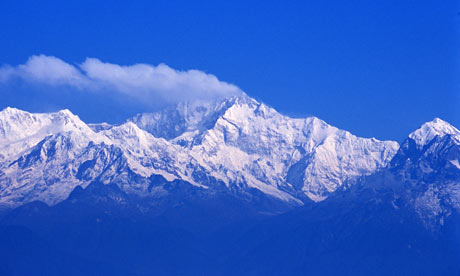 I'm not at all sure what to make of this report just out in the Guardian. Apparently, the Indian Environment Ministry has just issued a report (here in PDF) saying that they see no signal of a climate effect of greenhouse gas emissions on the retreat of Indian glaciers:
I'm not at all sure what to make of this report just out in the Guardian. Apparently, the Indian Environment Ministry has just issued a report (here in PDF) saying that they see no signal of a climate effect of greenhouse gas emissions on the retreat of Indian glaciers:The report is noteworthy because it contradicts the 2007 report of the IPCC:Jairam Ramesh, India's environment minister, released the controversial report in Delhi, saying it would "challenge the conventional wisdom" about melting ice in the mountains. . .
Today Ramesh denied any such risk existed: "There is no conclusive scientific evidence to link global warming with what is happening in the Himalayan glaciers." The minister added although some glaciers are receding they were doing so at a rate that was not "historically alarming".
Two years ago, the Intergovernmental Panel on Climate Change (IPCC), the UN agency which evaluates the risk from global warming, warned the glaciers were receding faster than in any other part of the world and could "disappear altogether by 2035 if not sooner".Predictably and understandably, Rajendra Pachauri, chairman of the IPCC, takes strong exception to the report. However, his response, far from being measured and focused on the data is a bit over the top and focused on credibility not the actual science of Indian glaciers:
Rajendra Pachauri, the chairman of the IPCC, told the Guardian: "We have a very clear idea of what is happening. I don't know why the minister is supporting this unsubstantiated research. It is an extremely arrogant statement." . .How do I make sense of this? Right now I don't. Given that my own personal experience with the IPCC is mixed at best, I'd rather hear more arguments about the evidence than the appeals to authority and credentials. So I guess for now I am reserving any judgments on what is going on here, though I have placed some inquiries. If I learn anything of interest I will report back.Pachauri dismissed the report saying it was not "peer reviewed" and had few "scientific citations".
"With the greatest of respect this guy retired years ago and I find it totally baffling that he comes out and throws out everything that has been established years ago."
In a remarkable finding, the report claims the Gangotri glacier, the main source of the River Ganges, actually receded fastest in 1977 – and is today "practically at a stand still".Some scientists have warned that the river beds of the Gangetic Basin – which feed hundreds of millions in northern India – could run dry once glaciers go. However, such concerns are scotched by the report.
According to Raina, the mistake made by "western scientists" is to apply the rate of glacial loss from other parts of the world to the Himalayas. "In the United States the highest glaciers in Alaska are still below the lowest level of Himalayan glaciers. Our 9,500 glaciers are located at very high altitudes. It is completely different system."
"As long as we have monsoons we will have glaciers. There are many factors to consider when we want to find out how quickly (glaciers melt) … rainfall, debris cover, relief and terrain," said Raina.
In response Pachauri said that such statements were reminiscent of "climate change deniers and school boy science".
"I cannot see what the minister's motives are. We do need more extensive measurement of the Himalayan range but it is clear from satellite pictures what is happening."
Many environmentalists said they were also unconvinced by the minister's arguments. Sunita Narain, a member of the Indian prime minister's climate change council and director of the Centre for Science and Environment, said "the report would create a lot of confusion".
"The PM's council has just received a comprehensive report which presents many studies which show clear fragmentation of the glaciers would lead to faster recession. I am not sure what Jairam (Ramesh) is doing."